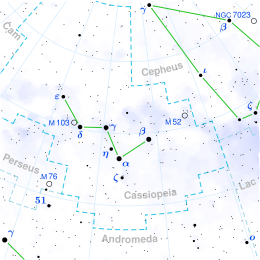| Observation data Epoch J2000 Equinox J2000 | |
|---|---|
| Constellation | Cassiopeia |
| Right ascension | 01h 08m 16.30295s[1] |
| Declination | +54° 55′ 12.5612″[1] |
| Apparent magnitude (V) | 5.159[2] (5.14/11.45[3]) |
| Characteristics | |
| Spectral type | G5Vb[4] + M4V[5] |
| U−B color index | +0.10[6] |
| B−V color index | 0.695±0.006[5] |
| Variable type | Suspected[7] |
| Astrometry | |
| Radial velocity (Rv) | −98.3[2] km/s |
| Proper motion (μ) | RA: +3,468.251[1] mas/yr Dec.: −1,564.844[1] mas/yr |
| Parallax (π) | 130.2881 ± 0.4348 mas[1] |
| Distance | 25.03 ± 0.08 ly (7.68 ± 0.03 pc) |
| Absolute magnitude (MV) | 5.78/11.6[8] |
| Orbit[5] | |
| Companion | μ Cas B |
| Period (P) | 21.568±0.015 yr |
| Semi-major axis (a) | 0.9985±0.0013″ |
| Eccentricity (e) | 0.5885±0.0011 |
| Inclination (i) | 110.671±0.064° |
| Longitude of the node (Ω) | 223.868±0.064° |
| Periastron epoch (T) | 1,997.2235±0.0067 |
| Argument of periastron (ω) (secondary) | 330.37±0.18° |
| Details[5] | |
| Aa | |
| Mass | 0.7440±0.0122 M☉ |
| Radius | 0.789±0.008 R☉ |
| Luminosity | 0.445±0.005 L☉ |
| Surface gravity (log g) | 4.515±0.011 cgs |
| Temperature | 5,306±31 K |
| Metallicity [Fe/H] | −0.81±0.03 dex |
| Rotational velocity (v sin i) | 2.4 km/s |
| Age | 12.7±2.7[5] 3.1[2] 5.9[9] Gyr |
| Ab | |
| Mass | 0.1728±0.0035[5] M☉ |
| Radius | 0.29[3] R☉ |
| Luminosity | 0.0062[3] L☉ |
| Temperature | 3,025[3] K |
| Other designations | |
| Database references | |
| SIMBAD | data |
Mu Cassiopeiae, Latinized from μ Cassiopeiae, is a binary star system in the constellation Cassiopeia. This system shares the name Marfak /ˈmɑːrfæk/ with Theta Cassiopeiae, and the name was from Al Marfik or Al Mirfaq (المرفق), meaning "the elbow".[10] It is dimly visible to the naked eye as a point of light with an apparent visual magnitude of 5.16.[2] The system is located at a distance of 25 light years from the Sun based on parallax, and is moving closer with a high radial velocity of −98 km/s.[2] This star will move into the constellation Perseus around 5200 AD.[11]
Mu Cassiopeiae is given as a standard star for the spectral class G5Vb,[4] although it is frequently described as a subdwarf, meaning it has a luminosity below that expected for a G5 main sequence star.[12] The metallicity, or abundance of heavy elements, is about one-sixth that in the Sun.[5] It is slightly smaller than the Sun with less mass and a lower luminosity.[5]
This is one of the first high-velocity stars to be identified.[5] Compared to other nearby stars including the Sun, this pair are moving at a relatively high velocity of 167 km/s through the Milky Way galaxy.[5] They are low metal, Population II stars that are thought to have formed before the galactic disk first appeared.
- ^ a b c d e Cite error: The named reference
dr3was invoked but never defined (see the help page). - ^ a b c d e Cite error: The named reference
aaa418_989was invoked but never defined (see the help page). - ^ a b c d Cite error: The named reference
drummondwas invoked but never defined (see the help page). - ^ a b Cite error: The named reference
perkinswas invoked but never defined (see the help page). - ^ a b c d e f g h i j Cite error: The named reference
Bond_et_al_2020was invoked but never defined (see the help page). - ^ Cite error: The named reference
apj1_233_211was invoked but never defined (see the help page). - ^ Cite error: The named reference
gcvswas invoked but never defined (see the help page). - ^ Cite error: The named reference
jaowas invoked but never defined (see the help page). - ^ Cite error: The named reference
apj687_2_1264was invoked but never defined (see the help page). - ^ Cite error: The named reference
allen1963was invoked but never defined (see the help page). - ^ Cite error: The named reference
moorewas invoked but never defined (see the help page). - ^ Cite error: The named reference
apj683_1_424was invoked but never defined (see the help page).
